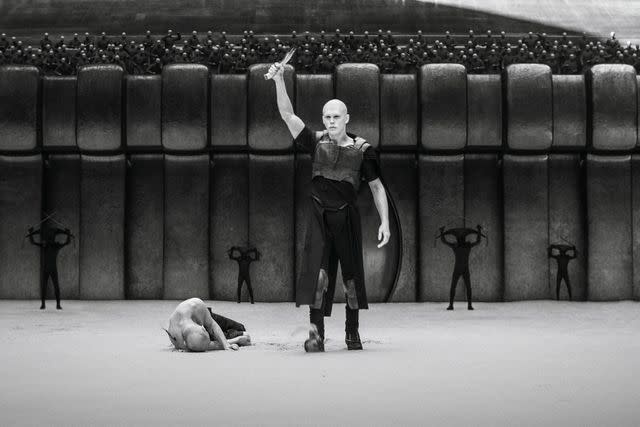“Dune: Part 2”'s Harkonnen homeworld was inspired by septic tanks

- Oops!Something went wrong.Please try again later.
- Oops!Something went wrong.Please try again later.
- Oops!Something went wrong.Please try again later.
- Oops!Something went wrong.Please try again later.
Oscar-winning production designer Patrice Vermette and cinematographer Grieg Fraser break down that black-and-white gladiator sequence.
Giedi Prime was glimpsed briefly in 2021's Dune film, but director Denis Villeneuve wanted to change up the look of House Harkonnen's desolate homeworld for Dune: Part Two (now streaming on Max), his second movie based on Frank Herbert's iconic sci-fi novel. From the moment he wrote the script, Villeneuve visualized the gladiator sequence (where Austin Butler's Feyd-Rautha proves his mettle to his future subjects by battling Atreides warriors to the death in a giant arena) as black-and-white.
Production designer Patrice Vermette, a longtime collaborator of Villeneuve who won an Oscar for his work on the first Dune, refers to this decision as a "game-changing" moment. Multiple departments (not just production design but also cinematography and costumes) required a lot of research and development to make the sequence work. But the design aspect all clicked into place for Vermette one day while he was driving outside Montreal.
"I came across this field of septic tanks being sold by a vendor," Vermette tells Entertainment Weekly. "Denis had always envisioned Giedi Prime to be a world of black plastic, and I was driving in that day, those black molded plastic septic tanks had this gloss, and there was a veil of dust on them. The way that the sun was hitting them, I was like, 'my God, this could be Giedi Prime,' because of the number of different types of septic tanks they had there."
Want more movie news? Sign up for Entertainment Weekly's free newsletter to get the latest trailers, celebrity interviews, film reviews, and more.

Warner Bros. Pictures
Roger Yuan and Austin Butler in 'Dune: Part Two.'Vermette continued, "So I researched the molds with my concept artist. We started having fun redesigning the structure of those tanks. Even beyond the aesthetics which were great, the meaning behind septic tanks and what's actually inside totally fitted with the Harkonnens themselves. Everything worked with everything."
Villeneuve envisioned Giedi Prime as being lit by a black sun, which you can see in the sequence. It was cinematographer Greig Fraser (who also won an Oscar for his work on the first Dune) who came up with the idea to capture that by filming with infrared cameras. Having previously used them in various camera tests over the years, as well as certain scenes of Zero Dark Thirty, Fraser was able to demonstrate infrared's potential for Villeneuve. The director was immediately interested.
Related: How the Dune: Part 2 ending sets up Dune Messiah
"It felt like a really natural way to tell a story and say, 'Well, the sun has no light,'" Fraser says. "Not only does it have no visible light, it has no color. So while our eyes have evolved to see greens and blues and reds, those don't exist on Giedi Prime because the sun doesn't emit those wavelengths. We don't necessarily need to explain that backstory, but I think it just instantly tells the story where you see that their skin is that way for a reason."
Giedi Prime is a world of extreme exploitation. The Harkonnens have all but destroyed their world by sucking out all its resources, which explains why they've moved on to Arrakis and its unique spice melange. In addition to septic tanks, Vermette cites bugs as a major visual influence on the Harkonnens.
"The shape of the Harkonnen harvester is based on a tick," Vermette says. "Like the animal that sucks up your blood, this sucks up the natural resources of Arrakis. The look of Harkonnen ships is inspired by the morphology of insects."
Read the original article on Entertainment Weekly.

